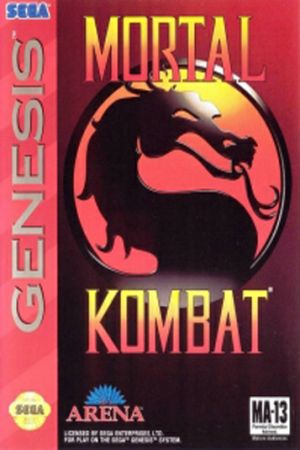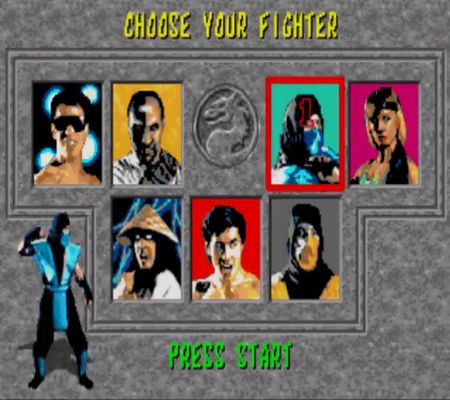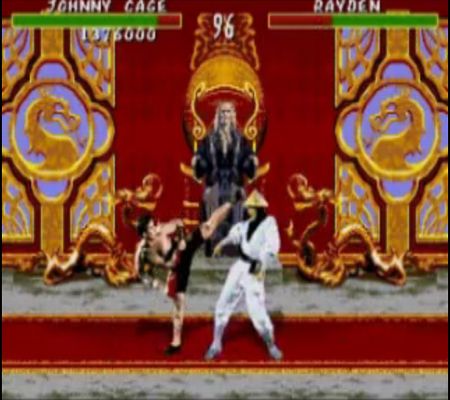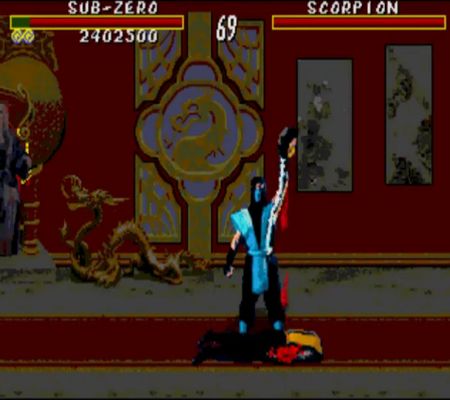Welcome to another edition of Genesis Does. The review article that looks at all things Sega Genesis. We’ve talked about a lot of action platformers over the last few weeks, so it’s definitely time to shake things up. It’s time to take the gloves off and engage in some good old fashioned fighting. Now, the Genesis era was definitely a time when fighting games were starting to come into their own, and many major names came, and many inferior titles went. But one franchise rose its bloody first in the air and dominated. And that was the Mortal Kombat franchise. And this week, Genesis Does looks at the debut title in this franchise. Was it a flawless victory?
YEAR OF RELEASE: 1993
PUBLISHER: Arena/Acclaim
GENRE: Fighting
In the early 90’s, the fighting genre was starting to become a hit in the arcades, thanks mainly to a little game known as Street Fighter 2. The game’s success opened the floodgates for other fighting games to follow. But the one that would prove to be the biggest challenger to Street Fighter’s dominance was Mortal Kombat.
Originally, Mortal Kombat was planned to be a action game starring action film star Jean Claude Van Damme, however Van Damme’s schedule at the time led to things falling out. So, creators Ed Boon and John Tobias would take the game and make it a fighting game instead, in an attempt to compete with Street Fighter 2, which as mentioned prior, was a dominant beast in the arcade.
The arcade game was released in 1992, and was an almost instant hit. The gameplay, and digitized characters, along with the addition of blood and gore, not to mention the brutal fatalities, were a massive sell to young audiences. And every Kombat fan was chomping at the bit to take this bad boy home. On September 13th, 1993, a date dubbed Mortal Monday, the game was released on multiple consoles including most notably the SNES and Genesis.
However, the game’s success wouldn’t be without controversy. It went under fire by public officials and parental groups, including Senator Joe Liberman, for its depiction of real life violence. These hearings would eventually lead to the eventual creation of the ESRB. This controversy would also lead to one of Nintendo’s more legendary bad decisions, and an occasion where Sega’s port would be a better one than Nintendo, which had decided to remove all blood, as well as augment the fatalities so that they wouldn’t be as brutal. Sega would still give players blood and gore through use of a blood code that had to be pressed in the beginning of the game (ABACABB).
The game’s success would also spawn a motion picture in 1995, which held as close as possible to the game’s story. There were many sequels to Mortal Kombat, as well as spinoff games, an animated series, a live action series, and an infamously bad sequel to the original MK film. MK is a legendary title on the Genesis for so many reasons. But has this game’s legendary status truly held up?
COVER STORY
Really can’t say too much about this one. The cover is very basic, but it works. The logo is very classic and cool, and it’s an easy enough eye catcher. Other than that, yeah, it’s simple, and effective.
STORY
Once again, the Mortal Kombat tournament is taking place. A brutal battle for the freedom of the Earthrealm, from the invading Outworld. Earthrealm has lost the last nine tournaments, and with this being the tenth, the freedom of the Earthrealm is on the line. Seven warriors have been chosen to compete, each with their own reasons for joining the competition. Can one of these warriors prove victorious, and defeat the evil Shang Tsung, and his ally, the deadly beast Goro?
GAMEPLAY
Mortal Kombat is a fighting game for one to two players. You control a fighter as you have to defeat other fighters to eventually win the Mortal Kombat tournament. Like most fighting games on the console, a six button activator controller is definitely a necessity. With the six button, you can low punch with A, high punch with X, low kick with C, high kick with Z, and block with both the B and Y buttons.
Gameplay is as basic as most fighting games. It’s a best of three fight. First to lower their opponent’s health all the way is victorious. Once you win two rounds, you will be given the option to finish your enemy with your finishing move, also known as a Fatality. These brutal moves are done with specific button combinations, as well as being in a certain spot to hit them. Each of the seven fighters has one fatality, along with several special moves that each can execute with certain button combos.
You can choose from one of seven different fighters. Each with their own unique fighting styles, special moves, and back stories. These kombatants are as follows:
Liu Kang: The game’s true protagonist. Formerly of the White Lotus Society, a group of shaolin monks, Liu enters the tournament to defeat the evil Shang Tsung once and for all, and to protect the Earthrealm’s freedom.
Liu Kang’s special moves are a flying kick and a fireball, he’s very well rounded as a character. His fatality is the least violent in the game, which is a cartwheel kick, followed by an uppercut. Not really brutal, but still effective.
Johnny Cage: A major martial arts movie star, Johnny Cage is egotistical and arrogant. Pretty much like any other film star. Cage enters the tournament with the belief that being champion will help his career skyrocket. An interesting note on Johnny Cage is that he was originally who Jean Claude Van Damme was supposed to be in this game, hence the fact that his initials are J.C.
Johnny has a green fireball that he can throw, a shadow kick, and can also do a split which is followed by a punch to his enemy’s groin (he can do this move to everyone but Sonia). His fatality is an uppercut that will knock his opponent’s head off.
Sonya Blade: A member of a special forces unit, Sonya learns that Kano, a mercenary from the Black Dragon has been spotted in the Mortal Kombat tournament. Sonya enters the contest to finally put Kano down once and for all. Sonya is also the only female in the game.
Sonya’s special moves include a head scissors, and an energy blast. With her fatality, she blows a fiery kiss to her enemy, which will engulf them in flames.
Kano: One of the most ruthless mercenaries ever, and a member of the evil Black Dragon, Kano has entered the Mortal Kombat tournament in order to reap the many rewards that he believes Shang Tsung to have.
Kano’s special moves are a spinning cannonball attack, as well as knives he can throw. His fatality has him ripping out the still beating heart of his opponent.
Raiden: The god of thunder himself. Raiden is the Earthrealm’s sworn protector. Fearing that Shang Tsung’s victory will lead to the Earthrealm’s destruction, Raiden takes the form of a mortal human to enter in the competition, to save Earthrealm once and for all.
Raiden’s main moves are a flying attack that pushes an enemy into a corner, and a thunder shot. His fatality is a thunderbolt that blows his enemy’s head off.
Sub Zero: A member of the group of ninja assassins known as the Lin Kuei. As his name and blue attire would imply, Sub Zero is a master of ice moves. He is sent by the Lin Kuei to assassinate Shang Tsung and take any treasure he may claim.
Sub Zero’s moves include an ice attack that freezes his enemies temporarily, as well as a slide attack. His fatality has him rip his opponent’s head off, with the spinal cord still attached. This is the fatality that really spearheaded a lot of the controversy that would follow MK. Later ports of the game that would bring classic Sub Zero back, would fade the screen to black whenever he went for the head rip fatality.
Scorpion: Scorpion’s origins are unknown. All that is known is he is a ninja that was killed by Sub Zero. Scorpion has been reincarnated with a new body in order to enter the Mortal Kombat tournament and get his revenge on Sub Zero.
Scorpion’s moves are a harpoon that will pull his opponent towards him (GET OVER HERE!!), and a teleport punch. His fatality has him rip his mask off to reveal his skull face. He then spits out a fireball that will blow his enemy up. This is my personal favorite fatality in the game, and has been one that has been used for Scorpion for almost every game since.
Once you choose one of the kombatants, you play through the main game mode. In it, you have to beat all six opponents, as well as a mirror match with yourself. Then you face off in three endurance matches, which are one on two battles. Finally, it’s the final matches with Goro, and Shang Tsung.
Goro is a being known as a Shokan. A giant dragon-human creature with four arms. He can be very dangerous if he gets a hold of you. He isn’t the most difficult boss ever, but if you aren’t expecting a fight, you’ll be beaten quick. After that is the main villain Shang Tsung. he can shoot fireballs, as well as transform into any of the kombatants at any time. One you beat him, you are declared the Mortal Kombat champion, and you’ll receive your character-specific ending.
In the middle of the matches are bonus rounds that test your might. In these, you have to chop through wood, concrete, and finally steel. Just tap the buttons as fast as possible to get the meter over the line needed to complete it and press start. The tougher the challenge, the higher the line. These aren’t important to win unless you really care about your point score.
You’ll fight in several arenas, including a statue room, Shang Tsung’s throne room, Goro’s lair, and a bridge. With the bridge level, you can execute a fatality that can knock your opponent off into the pit below. This level is also where you have a chance to face off with a secret character known as Reptile. Though getting Reptile is easier said than done.
The game is pretty basic for a fighter, there isn’t much in terms of major combos, or super strategy, especially compared to the later MK titles. There isn’t much hit detection issues, nor any problems with the controls. The Genesis port is actually well handled compared to many of the ports on other consoles, especially the really sloppy SNES port.
The game’s difficulty depends on the starting level you choose from the options menu, but for the most part, the difficulty on the Genesis version seems to be the easiest overall. Enemies can still be super cheap, but never insanely annoying as they do in other ports. You have several continues, but no passwords or save function, as to be expected in a fighting game such as this.
CHEAT SHEET
Ever feel like being a dullard? Well, Mortal Kombat encourages it. By pressing Down, Up, Left, Left, A, Right, Down on the controller at the title screen, you will open the cheat mode. This mode will activate blood, put you in any starting level, or bonus mode. You can also set different flags, that will do different tricks, including help in finding Reptile.
GRAPHICS
The game has solid graphics for the Genesis port. The characters are smaller, and the backgrounds are definitely lacking compared to the arcade, or even the SNES versions, but it still manages to hold up, and look really well despite the console’s limitations. Definitely a well done attempt.
MUSIC
An interesting thing about this port is that the Genesis version uses its own songs, and not the tracks from the arcade. And personally, I enjoy these songs far more. They all have their own unique sound, and are very epic. Even with the notorious sound limitations of the Genesis, this is still a quality soundtrack, and I definitely feel it is vastly underrated when it comes to the greatest video game soundtracks of all time. There are a plethora of quality tracks that definitely deserve a listen, like the title screen, the throne room, and Goro’s lair.
OVERALL THOUGHTS
This is the first port of Mortal Kombat I ever played. Being a Genesis kid with really no other options, and no Arcade close to me, there really weren’t very many other options when it came to playing this game. And when I first rented it back in 1994, I was hooked. It has great graphics for the Genesis, a solid soundtrack, and plays and controls well. Plus, of course, there were those oh-so-wonderful fatalities, which were epic for a nine year old kid at the time such as myself. And playing it again years later, it’s still fun. I personally think it hasn’t held up as well as some other games in the franchise, but for what it is, it’s still a solid basic fighting game, and definitely still deserving of a play from anyone. So, definitely give this game a play if you haven’t, it’s worth it.
RATING: Thumbs Up.





